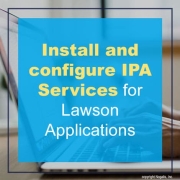Install and configure IPA Services for Lawson Applications
The IPA Services for Infor Lawson product (lpaservice.jar) contains the definition for each service.
These steps describe how to download, install and configure the services.
Download and install the services
- Download IPA Services for S3 from the Infor Product Download Center.
- Transfer the .jar file to your IPA server.
- Extract the contents of the .jar file to a new temporary directory.
jar –xvf lpaservice.jar
- Run the installation program from the temporary directory. Use the data area created in Landmark for IPA.
perl install-lpaservice.pl dataarea
- In order for Lawson applications to create workunits in IPA, standard workflow service data must be loaded onto the System Foundation (LSF) server.
In the temporary directory that you created, you will see the following directory structure and file:
YourTempDir/lsf/ wf-data-10.exp
Copy this file to your LSF environment in your normal install directory.
- Run the following command:
perl GENDIR/bin/pflowimpexp.pl imp wf-data-10.exp
NoteIf the installation provides feedback that some data was duplicated, you can ignore the message. This means that some or all of the workflow data already existed on the server which is not a problem.
- Verify that the services imported. View them on the IPA server. Navigate to: Start > Applications > Process Server Administrator > Configuration > Service Definitions
Configure email properties for IPA services
- From the IPA administration console on the IPA server, navigate to Configuration > System Configuration.
- Locate a configuration set named “ProcessFlowSolutions”.
- Verify that the configuration set should contains the following properties:
- FromEmailAddress
- ToEmailAddress
If the configuration set and/or the two properties do not exist, either re-install the product OR manually create the configuration to add the properties. Be sure to name them as shown above.
- Set the values of the properties to be meaningful for your organization.
- When you are finished updating, save the configuration.


Leave a Reply
Want to join the discussion?Feel free to contribute!